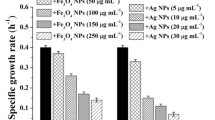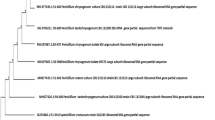Abstract
THE apparently common, action of such various protective compounds as cysteine, glycerol and thiourea1 suggests, from a chemical standpoint, a common chemical property. Such a property might be the metal chelating ability of compounds containing >N−, >S and >O atoms with unshared electrons2. It seemed possible, therefore, that added metals, especially transition metals, might sensitize bacteria if they act in the opposite sense to the known protective compounds. Accordingly, the effect of added cupric salts on bacteria was investigated and the results of the initial work are presented below. Cupric chloride was added to saline (0.067 M) suspensions of Shigella flexneri about 5–10 min before irradiation. The suspensions were irradiated with an electron beam (8 MeV) from the Medical Research Council linear accelerator, dose rate about 20 krads/min, under anoxia and aeration for each concentration of copper salt used. Techniques for gas bubbling and for irradiating suspensions with the 8-MeV electron beam have been described by Alper3. Survival after irradiation was estimated by plating samples after each dose on Difco–salt plates and counting colonies after 15 h at 37° C.
This is a preview of subscription content, access via your institution
Access options
Subscribe to this journal
Receive 51 print issues and online access
$199.00 per year
only $3.90 per issue
Buy this article
- Purchase on Springer Link
- Instant access to full article PDF
Prices may be subject to local taxes which are calculated during checkout
Similar content being viewed by others
References
Bridges, B. A., Rad. Res., 17, 801 (1962).
Lohman, W., et al., Experientia, 20, 90 (1964).
Alper, T., Intern. J. Rad. Biol., 1, 414 (1959).
Alper, T., Second Intern. Cong. Rad. Res., Harrogate, Abstracts, 38 (1962).
Anbar, M., Nature, 200, 376 (1963).
Anbar, M., and Rona, P., Proc. Chem. Soc., 244 (1963).
Bridges, B. A., Nature, 188, 415 (1960).
Bridges, B. A., J. Gen. Microbiol., 26, 467 (1961).
Bridges, B. A., Rad. Res., 16, 232 (1962).
Dean, C. J., and Alexander, P., Nature, 196, 1324 (1962).
Author information
Authors and Affiliations
Rights and permissions
About this article
Cite this article
CRAMP, W. Radiosensitization by Copper Ions, and Consequent Reversal of the Oxygen Effect. Nature 206, 636–637 (1965). https://doi.org/10.1038/206636a0
Issue Date:
DOI: https://doi.org/10.1038/206636a0
This article is cited by
Comments
By submitting a comment you agree to abide by our Terms and Community Guidelines. If you find something abusive or that does not comply with our terms or guidelines please flag it as inappropriate.



